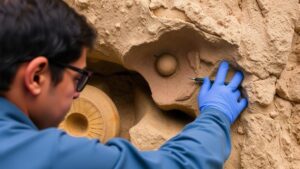The Science of Provenance: How to Document and Certify Your Fossil Finds
The Science of Provenance: How to Document and Certify Your Fossil Finds for Rockhounds and Mineral Collectors
For rockhounds and mineral collectors, documenting and certifying fossil finds is not just a matter of scientific interest; it also enhances the value and authenticity of the collection. Provenance, the history of ownership and origin of an artifact, is a critical component for collectors, providing insights into the authenticity, age, and scientific relevance of fossils. This article explores the science of provenance, the methods to document finds, and how to certify them properly.
Understanding Provenance
Provenance refers to the origin or source of something, particularly in the context of scientific specimens like fossils. Establishing provenance involves tracing the chain of ownership and ensuring that the fossil was collected legally and ethically.
In paleontology, provenance can play a role in research, conservation efforts, and determining the market value of fossils. For example, a well-documented fossil from a reputable site often commands a higher price than a piece with unclear origins. According to the International Fossil Dealers Association, fossils with certified provenance can sell for 20-50% more in some markets.
Documenting Your Fossil Finds
Proper documentation is vital for establishing the provenance of fossils. Collectors should adhere to a systematic approach that includes the following steps:
- Site Identification: Record the exact location where the fossil was found. Use GPS technology to obtain precise coordinates (latitude and longitude).
- Date of Collection: Note the date when the fossil was collected, as this information is essential for understanding its age and geological context.
- Physical Description: Describe the fossils features in detail, including size, color, and any notable characteristics. High-resolution photographs should accompany this description.
- Local Geology: Document the geological context of the find, detailing the surrounding rock formations, sediment types, and any associated fossils or artifacts.
By following these steps, collectors create a robust database that enhances the usefulness and value of their specimens.
Legal and Ethical Considerations
Before collecting fossils, it is crucial to understand the legal and ethical framework surrounding fossil collection in your area. Many regions have specific laws regarding the collection of fossils, especially on public lands. For example, in the United States, the Federal Land Policy and Management Act mandates that anyone wishing to collect fossils from public lands must obtain a permit.
Ethical collecting involves more than just adhering to laws; it includes consideration for conservation and respect for the site of collection. Collectors should prioritize collecting from designated areas and avoid sites that are ecologically sensitive or have restricted access.
Certification Processes
Once documentation is complete, collectors may seek certification from recognized institutions or organizations. Certification often provides a formal acknowledgement of the fossil’s authenticity, which can be important for both personal record-keeping and future sales.
- Professional Appraisal: Engaging a certified paleontologist or an accredited institution can help in evaluating the fossils significance and assigning a proper market value.
- Institutional Documentation: Many universities and museum collections have programs that allow collectors to submit their fossils for identification and certification.
- Online Platforms: Some online services offer authentication and certification programs, leveraging expert networks to value fossils and create certificates of authenticity.
Real-World Applications
In practice, successful documentation and certification can lead to multiple benefits for mineral collectors and rockhounds. For example, a rockhound who found a rare trilobite fossil in a known Cambrian formation could leverage their documentation and certification to:
- Increase the marketability of the fossil when it comes time to sell or trade.
- Contribute valuable data to ongoing paleontological research through donations to universities or museums.
- Participate in exhibitions and shows where provenance enhances credibility.
Conclusion and Actionable Takeaways
Documenting and certifying fossil finds is an integral part of responsible collecting. By applying scientific methods to establish provenance, collectors enhance their legal standing and ethical responsibility while preserving the integrity of the scientific record.
As you venture into fossil collecting, remember to:
- Thoroughly document every find, including location, description, and legal considerations.
- Seek certification from recognized institutions or professionals to establish authenticity.
- Engage with the fossil collector community to stay informed about best practices and legal changes.
By adhering to these guidelines, rockhounds and mineral collectors can ensure that their finds contribute meaningfully to the scientific community while enriching their personal collections.



